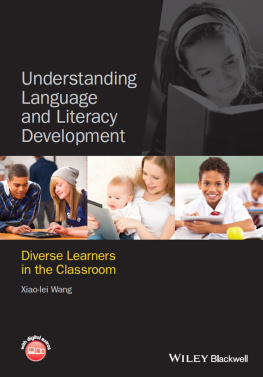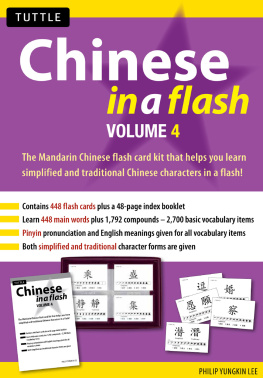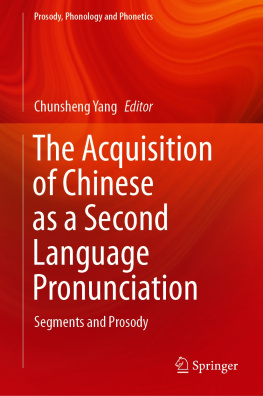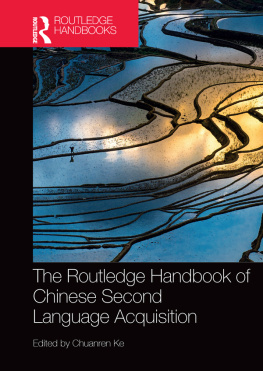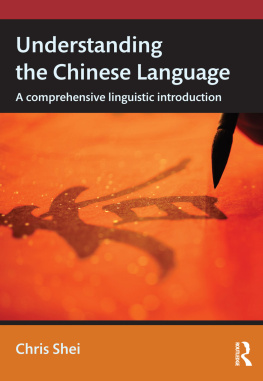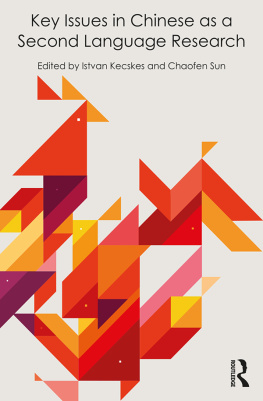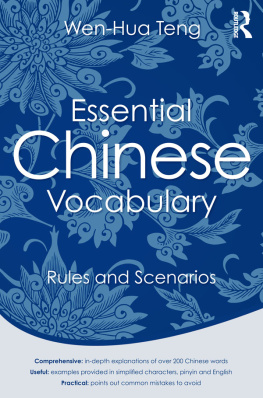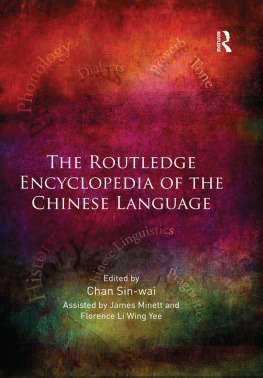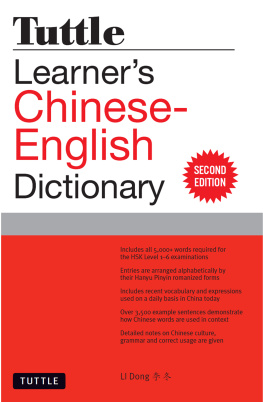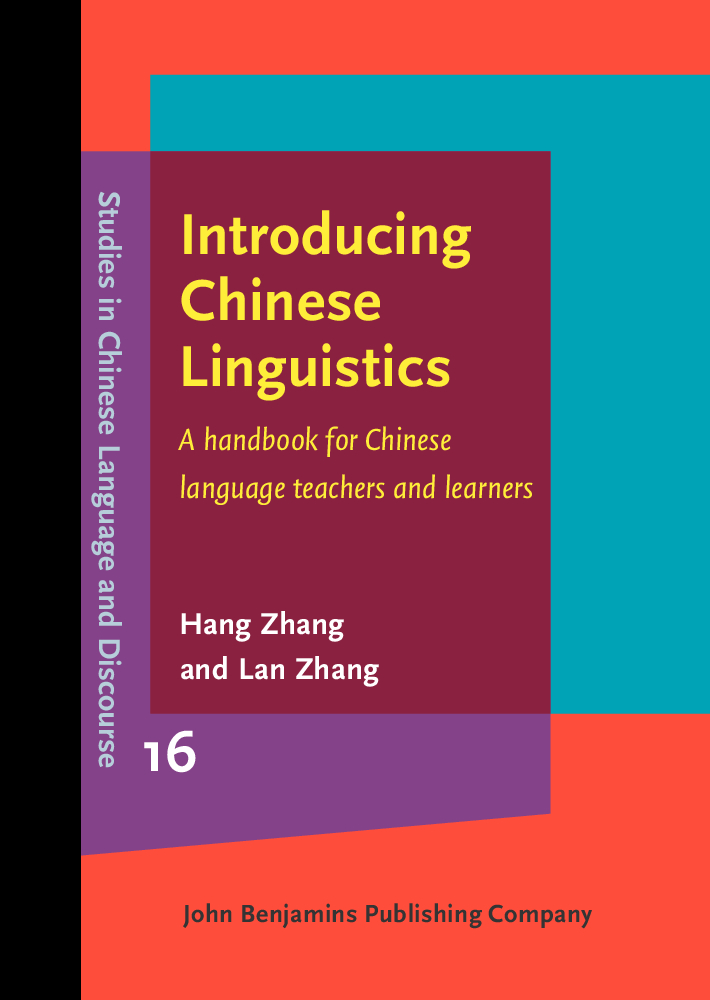

Introducing Chinese Linguistics
A handbook for Chinese language teachers and learners
Hang Zhang & Lan Zhang
doi: 10.1075/scld.16
ISBN: 978 90 272 5497 9 (ebook)
Cataloging-in-Publication Data available from Library of Congress: LCCN 2022041885
2023 John Benjamins Publishing Company
John Benjamins Publishing Company https://benjamins.com
List of abbreviations
CCTV
China Central Television
CvVc
Consonant-vowel-Vowel-consonant
IPA
International Phonetic Alphabet
GR
Gwoyeu Romatzyh (i.e., National romanization)
RVC
resultative verb compound
SLA
second language acquisition
Preface
The purpose of this book titled Introducing ChineseLinguistics: A Handbook for Chinese Language Teachers and Learnersis to introduce fundamental linguistic components of Mandarin Chinese thatfacilitate and enhance the teaching and learning of Chinese as a second language(L2). It will serve as a comprehensive guide to Chinese linguistics, providingan accessible introduction to each of the key areas: Chinese phonetics andphonology (i.e., sounds of language), morphology (i.e., how words arestructured), syntax (i.e., how sentences are formed), writing system (Chinesecharacters), and social cultural knowledge (i.e., how social and culturalfactors influence language use). This book offers a unique and customizedreading experience: it explains Chinese linguistics tailored to the needs of L2Chinese language educators and learners. In addition to core linguisticconcepts, this book discusses key features of Chinese language acquisition foradult learners. It highlights common challenges encountered by adult learnersnot typically covered in previous literature. The discussions on L2 challengesare supported by research findings to provide pedagogical implications forteachers and enhance learners linguistic awareness.
Structure of the book
The book consists of eight chapters. The first chapter isdesigned to familiarize readers with general linguistics, a brief history ofModern Standard Chinese (or Mandarin Chinese) and its dialects, and atheoretical background of L2 acquisition research. We hope to dispel commonmisconceptions people may have about linguistics and inspire students andteachers to explore Chinese linguistics.
The next seven chapters discuss the main branches of Chineselinguistics. introduces concepts in Chinese Pragmatics anddiscusses how Chinese language use is influenced by sociocultural factors,such as gender, language contact, and the Internet.
Each of these chapters () will compriseof the following features:
At the beginning of each chapter, we strive fora digestible presentation of basic linguistic concepts,so that readers at all levels with multifaceted goals can come tounderstand and appreciate how the Chinese language works;
The bulk of each chapter consists ofcomprehensive introductory text organized to teachthe unique facets of each fundamental area within Chineselinguistics;
Following the main body of the chapter is adiscussion of major findings in second language acquisition pertaining to the topic. This is tocontextualize how linguistic concepts such as tones in are acquired by adultlearners. The main purpose of this section is to alert readers ofmajor challenges during the acquisition process and providepedagogical assistance.
Extensive support for students. Tohelp students master concepts of Chinese linguistics, each sectionof a chapter concludes with a summary of key points,and closes with recommended readings and exercisequestions to reinforce the material and stimulate furtherthinking. The exercises function as practice tools toapply linguistic concepts on realistic Chinese language data and toevoke linguistic research interests, which users can select from tofit their needs.
Readership
With its accessible style, broad coverage and practical focus,this book is ideal for current and aspiring Chinese language teachersand serious learners of Chinese as a second language. We assumethat many readers may have some familiarity with language teaching orlearning but no previous knowledge of linguistics. Combining a comprehensiveoverview with in-depth treatment of topics in Chinese linguistics and secondlanguage acquisition, we use clear descriptions supported by modern examplesto guide readers through core topics of Chinese linguistics in an organizedfashion. This book can be used as a textbook for Chinese linguistics coursesin colleges or other educational institutions, especially Chinese languageteacher training programs. By providing relevant knowledge of secondlanguage acquisition of Chinese and complementary exercises, this book willbe a useful starting point for the rapidly increasing number of secondlanguage learners of Chinese to begin their study of this major worldlanguage. At the same time, in its depth and breadth, this book will also bebeneficial to a wide range of readers who are interested in Chineselinguistics, including many self-learners of Chinese linguistics, to extendand enrich their knowledge and competence in the language.
Below is some advice for how to best use this book fordifferent types of readers: the Chinese language teacher, the Chineselanguage student, and the Chinese linguistics teacher.
To the Chinese language teacher
This book was written to familiarize current and futureL2 Chinese language teachers with the linguistic structure of MandarinChinese. Language education is truly an interdisciplinary field. Inorder to teach successfully, language teaching professionals need to notonly have effective teaching skills and a high command of the language,but also knowledge on why and how the language works. Understanding thelearning process and the challenges learners face would be advantageous.Therefore, this book provides current and aspiring Chinese languageeducators with a clear pathway from general linguistics, to Chineselinguistics, and pedagogical applications. It also presentspedagogically relevant research findings in L2 Chinese acquisition toenhance and enrich teaching methodological practices.
Although linguistics is taken as the authoritative frameof reference for how language is pedagogically represented, we are notsuggesting a direct application in teaching. We suggest using theinformation on linguistic properties to restructure pedagogicaltechniques that improve students fluency and accuracy, rather thanimparting theoretical knowledge of linguistic concepts.



